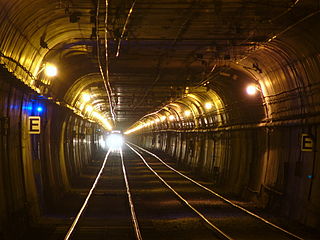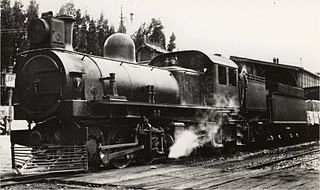
The London and Birmingham Railway (L&BR) was an early railway company in the United Kingdom, existing from 1833 to 1846, when it became part of the London and North Western Railway (L&NWR).

The Lancashire and Yorkshire Railway (L&YR) was a major British railway company before the 1923 Grouping. It was incorporated in 1847 from an amalgamation of several existing railways. It was the third-largest railway system based in northern England.
The Lancashire and Yorkshire Railway (LYR) built suburban electric stock for lines in Liverpool and Manchester. The line between Liverpool to Southport began using electric multiple units (EMUs) on 22 March 1904, using a third rail 625 V DC. Additional trains were later built for this route, and in 1913 incompatible stock for the route to Ormskirk. Lightweight units were built to run on the Liverpool Overhead Railway.

The Twin Peaks Tunnel is a 2.27-mile (3.65 km) long light rail/streetcar tunnel in San Francisco, California. The tunnel runs under Twin Peaks and is used by the M Ocean View/T Third Street and S Shuttle lines of the Muni Metro system.

The Beach Pneumatic Transit was the first attempt to build an underground public transit system in New York City. It was developed by Alfred Ely Beach in 1869 as a demonstration subway line running on pneumatic power. The subway line had one stop in the basement of the Rogers Peet Building and a one-car shuttle going back and forth. It was not a regular mode of transportation, and lasted from 1870 until 1873.
Neasden Power Station was a coal-fired power station built by the Metropolitan Railway for its electrification project. It was opened in December 1904. It was within the site of the current London Underground Neasden Depot.

The Ffestiniog Power Station is a 360-megawatt (480,000 hp) pumped-storage hydroelectricity scheme near Ffestiniog, in Gwynedd, north-west Wales, United Kingdom. The power station at the lower reservoir has four water turbines, which can generate 360 megawatts of electricity within 60 seconds of the need arising. The scheme has the capacity to power the whole of North Wales for several hours.

Cwm Dyli is the location of a hydro-electric power station on the southern flank of the Snowdon range in North Wales. At the time it was built, it was the largest hydro-electric power station in the United Kingdom. It is Britain's oldest power station, and is believed to be one of the oldest Grid-connected hydro-electric stations in the world.

Portishead Power Station refers to a series of two coal and oil-fired power stations which operated in the dock area of Portishead in Somerset, South West England, between 1929 and 1982.

Wangi Power Station is a heritage-listed former coal-fired power station at Wangi Wangi, City of Lake Macquarie, New South Wales on Lake Macquarie. The power station operated between 1956 and 1986 and supplied electricity to New South Wales. It was once the largest in the state. The 12,000 square-metre building was listed on the New South Wales State Heritage Register on 2 April 1999.

Agecroft power station was a coal-fired power station between the eastern bank of the Manchester, Bolton and Bury Canal and the western bank of the River Irwell at Pendlebury, near Manchester, England. It operated between 1925 and 1993, and was demolished in 1994. HM Prison Forest Bank has since been built on the site.
Cockle Creek Power Station was located in Teralba, New South Wales, Australia on the banks of Cockle Creek. The power stationed operated from 11 March 1927 until March 1976.
Neptune Bank Power Station was a coal-fired power station situated on the River Tyne at Wallsend near Newcastle upon Tyne. Commissioned in 1901 by the Newcastle upon Tyne Electric Supply Company, the station was the first in the world to provide electricity for purposes other than domestic and street lighting. It was also the first in the world to generate electricity using three-phase electrical power distribution at a voltage of 5,500 volts.
The London and Lake Erie Railway and Transportation Company is a defunct Interurban railway that operated in Ontario, Canada from 1902 to 1918. Originally chartered as the South Western Traction Company, the line was renamed the London and Lake Erie Railway in 1909. Throughout its short life, the line was always referred to locally as "The Traction Line".

Colenso Power Station was a coal-fired power station, located in Colenso on the banks of the Tugela River. It was built in the 1920s by the South African Railways to supply electricity for the railways, and was subsequently sold to the Electricity Supply Commission (Eskom).

Wilton Mill, Radcliffe was a cotton spinning mill in Radcliffe, Bury, Greater Manchester. It was built in 1907 and was taken over by the Lancashire Cotton Corporation in the 1930s and passed to Courtaulds in 1964. Production finished, it was used by the East Lancashire Paper Company but has now been demolished leaving an empty site next to the railways and the River Irwell.

The Port of Immingham, also known as Immingham Dock, is a major port on the east coast of England, located on the south bank of the Humber Estuary west of Grimsby, near the town of Immingham. In 2019, the Port of Grimsby & Immingham was the largest port in the United Kingdom by tonnage with 54.1 million tonnes of cargo passing through that year.

The South African Railways Class KM 0-6-0+0-6-0 of 1904 was an articulated steam locomotive from the pre-Union era in Transvaal Colony.

The Cape Government Railways Kitson-Meyer 0-6-0+0-6-0 of 1903 was a South African steam locomotive from the pre-Union era in the Cape of Good Hope.

The Lake Erie and Northern Railway was an interurban electric railway which operated in the Grand River Valley in Ontario, Canada. The railway owned and operated a north–south mainline which ran from Galt in the north to Port Dover on the shore of Lake Erie in the south. Along the way, it ran through rural areas of Waterloo County, Brant County, and Norfolk County, as well as the city of Brantford, where it had an interchange with the Brantford and Hamilton Electric Railway. Construction on the mainline began in 1913. The railway began operations in 1916 as a subsidiary of the Canadian Pacific Railway (CPR), which had purchased the line before construction had finished. In 1931, it was consolidated with the Grand River Railway under a single CPR subsidiary, the Canadian Pacific Electric Lines (CPEL), which managed both interurban railways, though they continued to exist as legally separate entities. Passenger service was discontinued in 1955 but electric freight operations continued until 1961, when the LE&N's electric locomotives were replaced by diesel CPR locomotives and the line was de-electrified. In the same year, service on the mainline from Simcoe to Port Dover was discontinued, but the remainder continued to operate as a branchline which as early as 1975 was known as the CP Simcoe Subdivision. The remainder of the line was officially abandoned in the early 1990s, ending almost seventy-five years of operation.
















